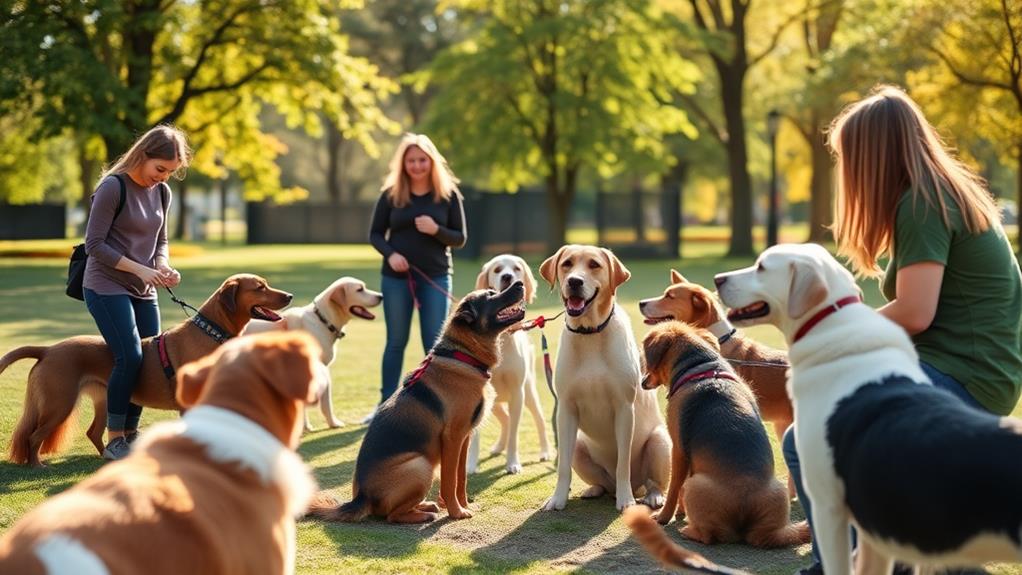Tailored programs effectively tackle the specific behavioral challenges your dog faces. Each dog is unique, influenced by their past experiences, environment, and breed. With a customized approach, you can identify triggers like boredom or anxiety and implement techniques such as positive reinforcement and desensitization. Integrating training into daily life helps reinforce good behaviors and strengthens your bond. Regularly evaluating your dog's progress allows for adjustments to optimize their training journey. By focusing on your dog's particular needs, you'll create an effective path toward improvement. Keep exploring to discover various strategies and resources available for further support.
Understanding Dog Behavior Challenges

Dogs can face a variety of behavior challenges that often stem from their environment, past experiences, or even genetic predispositions. Comprehending these challenges is crucial for you as a dog owner. Each dog is unique, and their behaviors can reveal a lot about their experiences. If a dog was poorly socialized as a puppy, it might struggle with interactions later in life, becoming anxious or aggressive in new situations.
Your dog's environment plays a significant role too. A chaotic household, lack of routine, or insufficient exercise can lead to stress and undesirable behaviors. Recognizing these triggers helps you create a supportive atmosphere for your furry friend.
Genetics also influence behavior; some breeds are predisposed to certain traits, such as herding or guarding instincts. It's essential to understand these natural tendencies to effectively manage your dog's behavior. By observing your dog and identifying these challenges, you can tailor your approach and training methods. This proactive stance not only helps you address behaviors but strengthens your bond with your dog, fostering a more harmonious relationship. Remember, patience and consistency are key in traversing these behavior challenges together.
Common Behavioral Issues in Dogs

Many dog owners encounter common behavioral issues that stem from the challenges discussed earlier. Recognizing these issues is the first step towards resolving them.
You might see your dog displaying certain behaviors that can be frustrating or concerning. Here are four common issues you may face:
- Excessive Barking: This can be triggered by boredom, anxiety, or a desire for attention. Understanding the root cause can help you address it effectively.
- Destructive Chewing: Dogs often chew on furniture or personal items when they're bored or anxious. Providing appropriate chew toys can redirect this behavior.
- Jumping on People: This behavior usually stems from excitement. Teaching your dog to greet people calmly can improve interactions and reduce stress.
- Pulling on the Leash: If your dog pulls during walks, it can be a challenge. Training them to walk on a loose leash can enhance your walking experience together.
The Importance of Tailored Programs

When addressing behavioral issues, a one-size-fits-all approach rarely works, as each dog has unique needs and circumstances. Tailored programs are essential because they consider your dog's specific temperament, environment, and the nuances of their behavior. This customization allows for a more effective resolution of issues, enhancing your dog's quality of life and strengthening your bond.
Here's a comparison of tailored programs versus generic approaches:
| Aspect | Tailored Programs | Generic Approaches |
|---|---|---|
| Understanding Needs | Deep assessment of behavior | Assumes all dogs are the same |
| Training Techniques | Customized methods | Standardized techniques |
| Owner Involvement | Active collaboration | Minimal guidance |
| Progress Monitoring | Regular adjustments | Fixed timelines |
| Results | Targeted improvement | Vague expectations |
Assessing Your Dog's Specific Needs

Understanding your dog's specific needs is the foundation for creating an effective behavioral program. Every dog is unique, and identifying what drives their behavior is essential. Start by observing your dog closely and taking note of the behaviors that concern you. Consider the following key factors:
- Age and Breed: Different breeds and age groups have varying energy levels and temperaments. For instance, a young Border Collie might require more stimulation than an older Bulldog.
- Health Status: Health issues can greatly impact behavior. A dog in pain may act out or withdraw, so it's important to rule out any medical problems with a vet check-up.
- Environment: Your dog's surroundings play a pivotal role in their behavior. Assess whether your home, yard, or neighborhood contributes to stress or anxiety.
- Past Experiences: A dog's history, including trauma or lack of socialization, can influence their current behavior. Understanding their background helps tailor your approach effectively.
Techniques for Behavior Modification

To effectively modify your dog's behavior, it's essential to employ a variety of techniques tailored to their specific needs. Start with positive reinforcement, rewarding your dog with treats or praise whenever they display desirable behavior. This encourages them to repeat those actions. Consistency is key, so make sure everyone in your household uses the same commands and rewards.
Another technique is desensitization, which involves gradually exposing your dog to the situations that trigger their unwanted behaviors. For example, if your dog barks at strangers, start by having them observe people from a distance, rewarding calm behavior, and slowly decreasing the distance over time.
Redirecting your dog's focus can also be effective. If your dog tends to chew on furniture, provide them with appropriate chew toys and encourage their use. When you catch them in the act, redirect their attention to the toy instead.
Lastly, patience is paramount. Behavior modification is a process that takes time. Monitor your dog's progress, adjusting your techniques as needed. With dedication and the right approach, you can foster lasting positive changes in your dog's behavior.
Integrating Training With Daily Life

Integrating training into your dog's daily life makes it easier for them to learn and adapt to desired behaviors. When you weave training into everyday activities, your dog will become more responsive and engaged.
Incorporate Commands During Walks: Use commands like "sit" or "stay" when you pause on walks. This keeps your dog focused and reinforces training in real-time.
Use Meal Times for Training: Make mealtime a training opportunity. Ask your dog to perform a command before you place their food bowl down. This reinforces good behavior.
Reward Good Behavior: Whenever your dog exhibits positive behavior, reward them immediately. This could be through treats, praise, or playtime, making the connection clear.
Practice During Play: Incorporate training into play sessions. Use fetch or tug-of-war to teach commands like "drop it" or "leave it," turning fun into learning.
Monitoring Progress and Adjustments
Effective monitoring of your dog's progress is essential for refining training techniques and ensuring long-term success. Start by keeping a journal where you note your dog's behaviors, reactions, and the effectiveness of different strategies. This helps you identify patterns and areas needing improvement.
Regularly assess your dog's responses to various commands or situations. If your dog seems to struggle with a particular behavior, consider adjusting your approach. For example, if a command isn't working, try breaking it down into smaller steps or using more enticing rewards.
Engage in consistent training sessions while keeping them varied to maintain your dog's interest. If you notice a lack of progress, reassess your methods and adjust accordingly. Sometimes, the timing of your cues or the environment can impact your dog's ability to learn.
Incorporate feedback from other trainers or dog behaviorists if you're unsure about certain aspects. They can provide valuable insights that you might overlook. Remember, training is a dynamic process. Stay flexible, and be willing to tweak your techniques to foster your dog's growth and confidence. Your ongoing commitment will pay off in building a stronger bond and achieving desired behaviors.
Resources for Ongoing Support

Having reliable resources at your fingertips can make all the difference in your dog training journey. When you face challenges, it's crucial to have support that can guide you in the right direction. Numerous platforms offer extensive courses tailored to specific behavioral issues. These courses often include videos and forums for community support.
Finding a qualified trainer nearby can provide hands-on assistance. They can assess your dog's behavior and offer personalized strategies. Look for trustworthy books and articles written by dog training experts. They often contain practical tips and in-depth insights into canine behavior.
Joining local or online dog owner groups can help you connect with others facing similar challenges. Sharing experiences and strategies can foster a supportive environment.
Frequently Asked Questions
How Long Does It Take to See Results From Tailored Programs?
It typically takes a few weeks to notice significant changes when you commit to a program. Your consistency and the specific methods used play an indispensable role in how quickly you'll see results.
Can I Use These Programs for Multiple Dogs at Once?
Think of each dog as a unique flower in a garden. You can use these programs for multiple dogs, but remember, each one might bloom at its own pace. Nurture them individually for the best results.
What Qualifications Should a Trainer Have for Tailored Programs?
When choosing a trainer, look for certifications in dog behavior, experience with various breeds, and positive reviews. They should communicate well and customize their approach to fit your dog's unique needs and challenges.
Are There Any Age Restrictions for Dogs in These Programs?
There aren't strict age restrictions for dogs in training programs. However, younger dogs may benefit from early socialization, while older dogs can still learn. It's important to assess each dog's individual needs and abilities.
How Do I Choose the Right Program Type for My Dog?
To choose the right program for your dog, consider their specific behavior issues, age, and temperament. Research options, ask for recommendations, and trust your instincts. You know your dog best, so prioritize their needs.
Conclusion
In the journey to transform your dog's challenging behaviors, remember that every pup is a unique puzzle waiting to be solved. By tailoring programs to fit your furry friend's specific needs, you're not just training; you're building a bridge of trust and understanding. As you integrate these techniques into daily life, watch as your bond strengthens and your dog blossoms. With patience and love, you'll turn obstacles into stepping stones, paving the way for a harmonious partnership.



